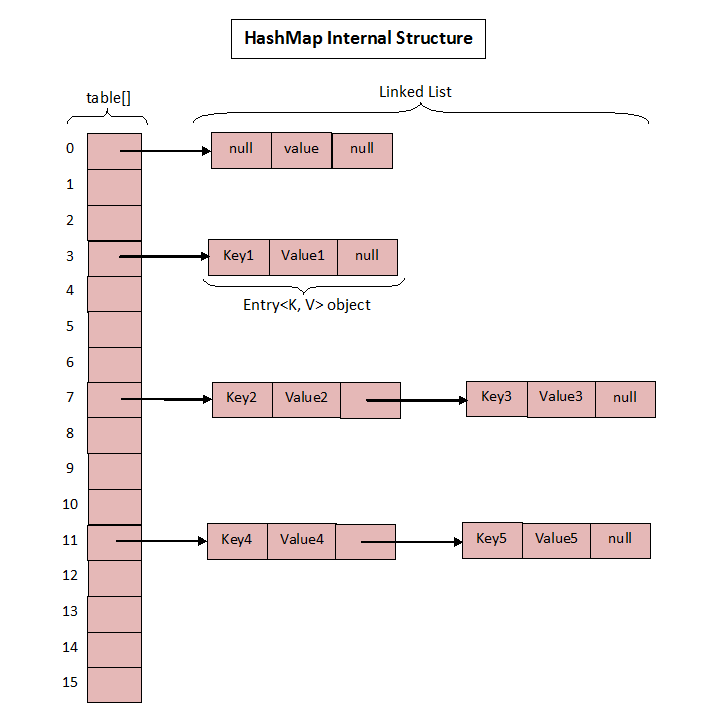JDK 1.8 对 HashMap 改进很多,1.8 中已经移除了 Entry 的这种实现方式了,改用了 Node,所以存储结构也发生了很大的变化,代码也从 1k 行膨胀到了 2k 行,这次梳理的是 1.7 的 HashMap 实现。1.8 下次再详细看看。
HashMap 继承 AbstractMap,实现了 Map 接口。
1 2 3 4 5 6 7 8 9 10 11 12 13 14 15 16 17 18 19 20 21 static final int DEFAULT_INITIAL_CAPACITY = 1 << 4; // 默认初始化容量值,16,要求 2 的 N 次幂(计算 table index 要求),可以在构造方法指定,如果在构造函数指定 50,那么 Map 会自动选择扩容到 50 以后的 2 次幂,即:64 static final int MAXIMUM_CAPACITY = 1 << 30;// 最大容量 static final float DEFAULT_LOAD_FACTOR = 0.75f;// 默认负载因子,可以在构造方法指定实际值 transient Entry[] table = (Entry[]) EMPTY_TABLE;// 所有 HashMap 实例初始化时,共享该值,表示空集合 transient int size;// Map 中 k-v 个数 int threshold;// 临界值,size >= 该值的时候,进行 resize final float loadFactor;// 负载因子,用于计算 threshold,threshold = (int)Math.min(capacity* loadFactor, MAXIMUM_CAPACITY + 1); transient int modCount;// 记录 Map 结构被修改的次数,这里的修改可能是 Map 的 size 改变,比如 put,remove,clear 等;rehash;当 clone 的时候,返回的克隆 Map 对象的 modCout 被为 0 static final int ALTERNATIVE_HASHING_THRESHOLD_DEFAULT = Integer.MAX_VALUE;// 默认替换散列阈值 private static class Holder.ALTERNATIVE_HASHING_THRESHOLD // 替换散列阈值,该值在 VM 启动以后初始化,如果系统属性(system property)数定义了 jdk.map.althashing.threshold >= 0 时,则使用定义的值作为该值;否则使用 Integer.MAX_VALUE。当调用 resize 或者 inflateTable 的时候,如果满足条件 capacity >= 该值,会进行 rehash,rehash 的目的是为了避免 hash 值的碰撞。 transient int hashSeed = 0;// hashSeed 用于计算 key 的 hash 值,它与 key 的 hashCode 进行按位异或运算。这个 hashSeed 是一个与实例相关的随机值,主要用于解决 hash 冲突。上面说到 rehash 其实就是事先改变 hashSeed 的值,以至于计算 key 的新 hash 值与原 hash 值不同
1 2 3 4 5 6 7 public HashMap(int initialCapacity, float loadFactor) public HashMap(int initialCapacity) public HashMap() public HashMap(Map<? extends K, ? extends V> m)
1 2 3 4 5 6 7 public V put(K key, V value) public V get(Object key) public V remove(Object key) public boolean containsKey(Object key)
(图片来源:http://javaconceptoftheday.com/how-hashmap-works-internally-in-java/)
1 2 3 4 5 6 static class Entry<K,V> implements Map.Entry<K,V> { final K key; V value; Entry<K,V> next; int hash; }
Entry 自身持有另外一个 Entry 对象 next,构成了链表的数据结构。
算哈希值 –> 算 table index –> 存。
1、检查 table ,如果 == EMPTY_TABLE,先按照指定的容量扩容 table ,即:table = new Entry[capacity],如果 capacity 的值不是 2 的 N 次幂,则 capacity 值会被修改为比 capacity 大的最近一个 2 的 N 次幂数。
2、检查 key == null ,如果是,则认为 key 的 hashValue 对应的 table index 为 0,否则需要计算 key 的 hashValue ,计算方法:
1 2 3 4 5 6 7 8 9 10 11 12 final int hash(Object k) { int h = hashSeed; if (0 != h && k instanceof String) { return sun.misc.Hashing.stringHash32((String) k); } h ^= k.hashCode(); // This function ensures that hashCodes that differ only by // constant multiples at each bit position have a bounded // number of collisions (approximately 8 at default load factor). h ^= (h >>> 20) ^ (h >>> 12); return h ^ (h >>> 7) ^ (h >>> 4); }
然后,计算 hashValue 对应的 table index ,方法:index = hashValue & (table.length-1);
这个运算相当于 hashValue 对 table.length 的取模运算。因为 table.length 是优化过的,是 2 的 N 次幂,所以可以这样计算。(数学原理参考另外篇文章:http://blog.fenxiangz.com/java-basic/thread-local/ ,ThreadLocalMap 部分)
最后,就算出了这个 key-value 对于的 table[index] 了。
3、put,如果 table[index] == null , 则直接 new Entry,存就好了;
否则,先计算 table[index] 链表上的所有 Entry e,确认是否有 e.hash == hashValue && e.key.equals(key) 的 e,
如果有,则用新的 value 替换旧的 e.value 并返回旧的 e.value;
否则,e1 = new Entry, table[index] = e1 ,并把原有的 table[index] 作为 e1.next。
存的过程,如果 (size>= threshold) && (null != table[index]),会导致 resize 扩容,并且如果满足条件 capacity >= Holder.ALTERNATIVE_HASHING_THRESHOLD 的时候会进行 rehash,rehash 的目的是为了避免 hash 值的碰撞。
rehash 的成本是很高的,所以,如果使用 HashMap 的时候,指定了 capacity ,capacity 应该尽可能的大于业务预期的大小。防止过程中 rehash。
